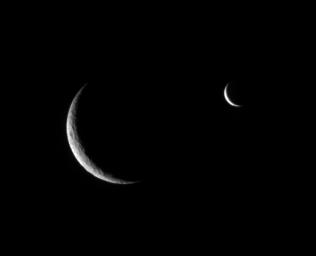Enceladus Approaches
Caption:
Rhea and Enceladus shared the sky just before the smaller moon passed behind its larger, cratered sibling.
This image is part of a "mutual event" series in which one moon passes close to or in front of another. These sequences help scientists refine the orbits of Saturn's moons.
Cratered Rhea is 1,528 kilometers (949 miles) across and presumed to be geologically dead. While much smaller, Enceladus (505 kilometers, or 314 miles across) is geologically active today.
The image was taken in visible light with the Cassini spacecraft narrow-angle camera on July 4, 2006 at a distance of approximately 1.4 million kilometers (800,000 miles) from Rhea and 1.9 million kilometers (1.2 million miles) from Enceladus. The view was obtained at a Sun-moon-spacecraft, or phase, angle of about 142 degrees relative to both moons. Image scale is 8 kilometers (5 miles) per pixel on Rhea and 11 kilometers (7 miles) on Enceladus.
Background Info:
The Cassini-Huygens mission is a cooperative project of NASA, the European Space Agency and the Italian Space Agency. The Jet Propulsion Laboratory, a division of the California Institute of Technology in Pasadena, manages the mission for NASA's Science Mission Directorate, Washington, D.C. The Cassini orbiter and its two onboard cameras were designed, developed and assembled at JPL. The imaging operations center is based at the Space Science Institute in Boulder, Colo.
For more information about the Cassini-Huygens mission visit
http://saturn.jpl.nasa.gov/home/index.cfm
. The Cassini imaging team homepage is at
http://ciclops.org
.
Cataloging Keywords:
| Name |
Value |
Additional Values |
| Target |
Rhea |
Enceladus |
| System |
Saturn |
|
| Target Type |
Satellite |
|
| Mission |
Cassini-Huygens |
|
| Instrument Host |
Cassini Orbiter |
|
| Host Type |
Orbiter |
|
| Instrument |
Imaging Science Subsystem (ISS) |
|
| Detector |
Narrow Angle Camera |
|
| Extra Keywords |
Crater, Grayscale, Visual |
| Acquisition Date |
|
| Release Date |
2006-07-26 |
| Date in Caption |
2006-07-04 |
|
| Image Credit |
NASA/JPL/Space Science Institute |
| Source |
photojournal.jpl.nasa.gov/catalog/PIA08229 |
| Identifier |
PIA08229 |

 Planetary Data System
Planetary Data System
